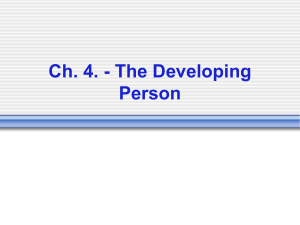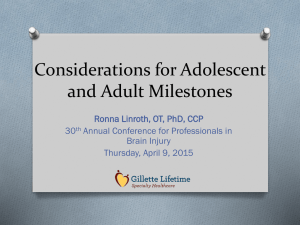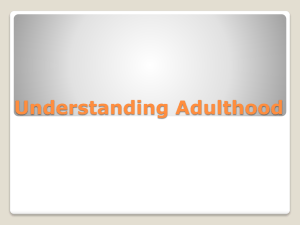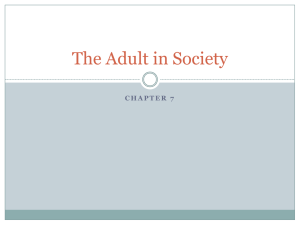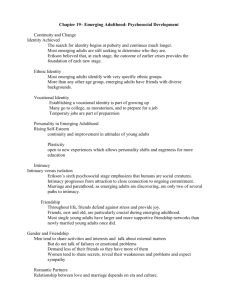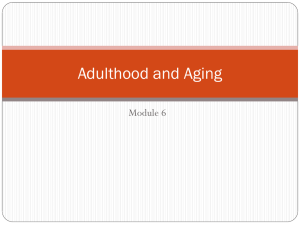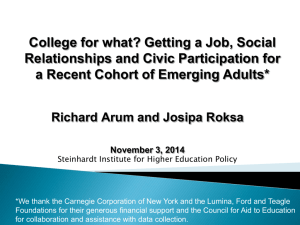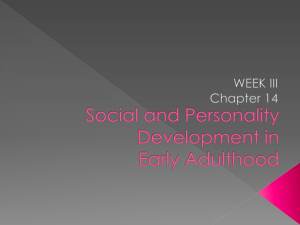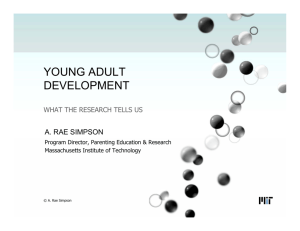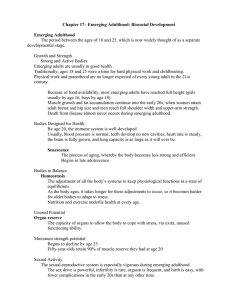HighSchoolCounselors-3-17-12
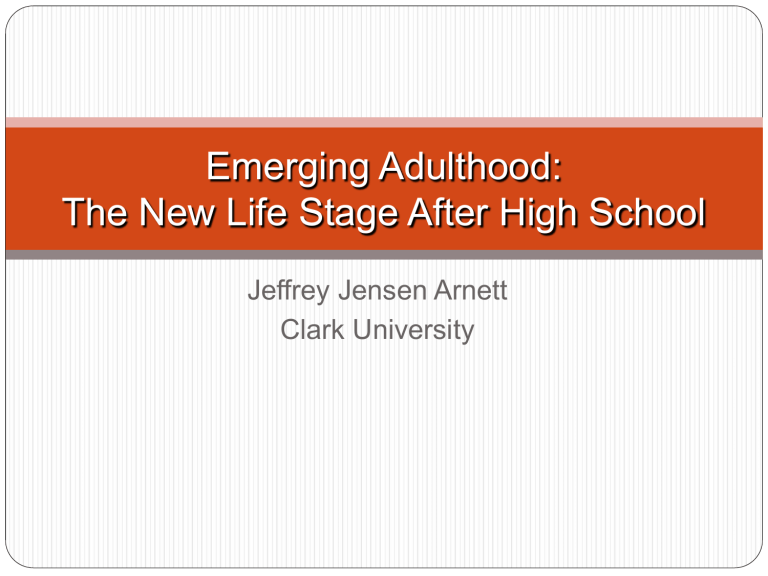
Emerging Adulthood:
The New Life Stage After High School
Jeffrey Jensen Arnett
Clark University
What is emerging adulthood?
Lasts from about age 18-25; for many, lasts through the twenties
Begins with the end of secondary school; ends with the attainment of full adult status--?
Exists mainly in industrialized societies, but growing in developing countries
Social changes leading to emerging adulthood
Later ages of marriage and parenthood
Longer and more widespread education
Birth control, fewer children
Tolerance of premarital sexuality, cohabitation
Changes in women’s roles
Ambivalence about adult status
70
60
50
40
30
20
10
0
1900
College Enrollment, 1900-2000
1920 1940
Year
1960 1980 2000
Median U.S. Marriage Age, 1950-2000
28
27
26
25
24
23
22
21
20
1950 1960 1970
YEAR
1980 1990 2000
MEN
WOMEN
Median Marriage Age (Females) in Selected Countries
Industrialized Countries Age Developing Countries Age
_____________________________________________
United States 26 Egypt 19
Sweden 32 Morocco 20
Germany 30 Ghana 19
France 29 Nigeria 17
Spain 30 India 20
Japan 28 Indonesia 19
Australia 28 Brazil 21
Five features of emerging adulthood
(Based on 300 interviews with American ages 18-
29, diverse backgrounds.)
The age of identity explorations
The age of instability
The self-focused age
The age of feeling in-between
The age of possibilities
The Age of Identity Explorations
Trying to find out “who I am”
Trying to find a place in the world in love and work
Love: searching for a “soul mate”
--”When you marry, you want to find your soul mate, first and foremost.” 94% of Americans 20-29 agree.
Work: searching for self-fulfillment; money is not enough
--“They pay well, but I hate my job! There’s no opportunity for growth there.” Tamara, age 22, legal assistant.
The age of instability
Average number of job changes from age 20-29 in U.S.: Seven
Rates of Moving, by Age
15
10
5
0
40
35
30
25
20
10-14x 15-19 20-24 25-29 30-34 35-44 45-54 55+
AGE
The self-focused age:
More independent from parents
Not yet tied to others
“I think I want to get more in touch with myself. I want to be a little selfish for awhile, and selfishness and marriage don't seem to go hand in hand. I'd like to be able to experience as much as I can before I get married, just so I can be wellrounded.” (Rosa, 24 year-old Latina)
The age of feeling in-between
Not yet fully adult, and definitely not “kids” or
“adolescents”
Adults in some ways but not others.
Do you feel that you have reached adulthood?
100
90
80
70
60
50
40
30
20
10
0 yes no yes and no
12-17x 18-25
Age
26-35 36-55
Do you feel that you have reached adulthood?
“Not absolutely, because I still sometimes get up in the morning and say, ‘Good Lord! I’m actually a grown up!’ ‘Cause I still feel like a kid. I’ve done things like just got up one morning and said, you know, ‘I’m going to Mexico’ and just get up and go. And I should have been doing other things.”
(Terrell, 23 year-old African American)
Top criteria
Accept responsibility for yourself.
Make independent decisions.
Financial independence
Bottom criteria
Finish education
Marriage
Parenthood
The age of possibilities
“I am very sure that someday I will get to where I want to be in life.”
96% of Americans ages 18-24 agree
The age of possibilities:
Do you think your life will be better or worse than your parents’ lives have been?
“Better economically. Better personally. I just think by the time my parents reached my age, they'd already run into some barricades that prevented them from getting what they wanted, personally and family-wise. And so far, I've avoided those things, and I don't really see those things in my life. I don't like my job.
I'm frustrated about the lack of relationships with females. But in general, I think I'm headed in the right direction.” (Bob, 23 yearold White American)
Variations by social class
Education looms large, now and later.
Age of finding a 5-year job: college grad, age 26; hs grad, age 28; hs dropout, age 35.
EAs from lower class backgrounds feel adult earlier, marry 2 years earlier, have children earlier.
BUT —the same five features apply across social classes.
Implications for Higher Education
Identity issues are key.
May take 56 years to get a “four-year” degree.
Even after bachelor’s degree, may head in new direction.
Mixed feelings about adulthood.
Optimistic, energetic, creative
Implications for High School
Counselors
Post-secondary education and training is more important than ever!
Few will know as high school seniors what the next decade will hold —even if they think they do!
Best strategy is to make a 5-year Plan —but be prepared to revise it.
Is It Generational?
Baby Boomers, Generation X… Y? Z?
Distinctive features of today’s EA generation:
The “new media” generation
More globally aware, globally connected.
More accepting of differences in religion, ethnicity, sexual orientation.
BUT: EA is here to stay
Trends in EA behavior, recent decades
men women
Performed volunteer work 71%, 1984 75%, 1984
81%, 2008 87%, 2008
Participated in organized demonstration 22%, 1966 15%, 1966
47%, 2006 53%, 2006
Socialized w/ someone of other racial/ethnic group 56%,1992 60%, 1992
69%, 2008 70%, 2008
Trends in EA behavior, recent decades
Drank beer in past year (men): 45%
Visited an art gallery or museum in past year
(men): 53%
“Emerging Adulthood: The Winding Road from the
Late Teens through the Twenties,” by Jeffrey
Jensen Arnett, Oxford University Press.
www.jeffreyarnett.com
